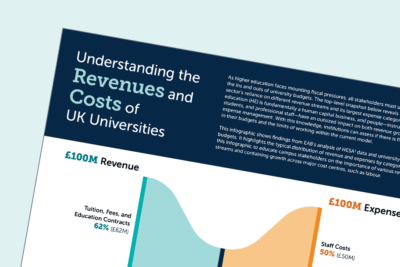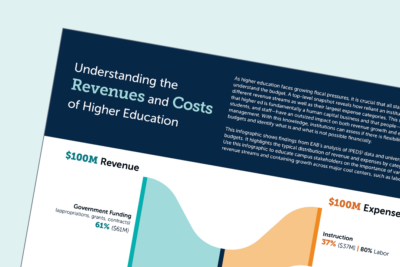5 Myths About Financial Exigency in Higher Education
Financial instability in higher education is a growing concern due to the enrollment cliff, reduced state funding, and rising operational costs. In response, some higher education leaders are considering declaring financial exigency to stabilize their institutions. As a last-resort measure, financial exigency enables drastic restructuring efforts—like program restructuring and faculty downsizing—that can help restructure budgets, manage debts, and sustain long-term viability.
While financial exigency remains an option for struggling institutions, misconceptions about what this decision means for campuses still persist. To help leaders separate fact from fiction when weighing financial strategy decisions, we debunked five common myths about financial exigency—and the information you should promote instead.
What is financial exigency?
Financial exigency is a formally declared state of severe financial distress that threatens the institution’s ability to sustain its core operations. It is typically characterized by an imminent and substantial shortfall in revenues that cannot be addressed through normal budgetary adjustments. Declaring financial exigency is typically a prerequisite for making drastic financial and personnel decisions, including the termination of tenured faculty, the closure of academic programs, and the reduction of administrative and operational expenses.
Myth 1: Short-term crises are sufficient grounds for declaring financial exigency
Some leaders assume that sudden revenue losses—such as those caused by economic downturns or shifts in federal and state funding—are sufficient grounds for financial exigency. However, the American Association of University Professors (AAUP), which serves as the de facto national authority on financial exigency, has not issued concrete guidance on whether these circumstances warrant a declaration.
Institutions should consider both their short-term financial situation and longer-term budget forecasts and downward trends when evaluating whether to declare exigency. For example, Central Washington University declared financial exigency in March due to short-term auxiliaries revenue losses caused by the state’s shelter-in-place order, as well as long-term projections about reduced state appropriations. Lincoln University declared prompted by state spending restrictions and accelerated projected long-term enrollment declines.
Myth 2: Institutions that declare financial exigency are destined for closure
Stakeholders often interpret a declaration as a precursor to institutional closure. In reality, financial exigency can help institutions avoid shutting down, since it allows leaders to restructure their cost bases to pay off unmanageable debts or close unsustainable deficits. For example, Chicago State University weathered a prolonged budget standoff in Illinois that deprived state colleges of funding for 10 months by declaring financial exigency and making reductions in force.
Further, Moody’s argues that financial exigency can be a credit-positive tool for universities in financial distress, since it signals a leadership team’s commitment to improving long-term financial sustainability.
Myth 3: Financial exigency violates shared governance and ignores faculty perspectives
A common misconception is that financial exigency bypasses shared governance by enabling leaders to make significant changes to academic programs and staffing without faculty consultation. In reality, faculty input is critical for successful implementation and most institutions have policies that require faculty involvement at every stage of the financial exigency process, starting with the initial review of an institution’s financial health.
For example, Texas Tech University must convene a Financial Exigency Advisory Committee (which includes the faculty senate president and three elected faculty representatives) to assess financial conditions. Similarly, Oklahoma State University requires presidential consultation with a standing faculty budget committee before declaring financial exigency.
Myth 4: Financial exigency allows institutions to rapidly reduce academic costs
Leaders believe that financial exigency will enable them to immediately scale back academic costs and provide financial relief. However, the process of declaring financial exigency and making associated budget reductions can be time-consuming, and cost savings can take at least a year to materialize. Typically, the president must review financial data, seek input from other campus leaders and faculty, and solicit and receive board approval before declaring financial exigency.
Following a formal declaration, institutional leaders must negotiate with division heads to develop budget reduction plans. For example, Tulane University gives individual schools a 30-day window to respond to the president’s proposed reductions and suggest alternative cost-saving measures. Then, tenured faculty selected for termination are entitled to an appeals hearing before a peer committee prior to dismissal. Moreover, some policies—like Old Dominion University’s—require institutions to give terminated faculty advanced notice, meaning they can stay on payroll for up to a year after termination decisions.
Ultimately, most institutions that declare exigency achieve cost savings by combining program discontinuance with broader academic workforce reductions. For example, Missouri Western State University, which declared financial exigency in March, downsized its faculty by 30%. The university’s plan included a mix of redesigning programs (like Chemistry and Mathematics), phasing out other programs (like Economics and Political Science), and reducing staffing across all 18 academic departments.
Myth 5: Financial exigency allows institutions to immediately revamp academic programs
Although financial exigency enables institutions to scale down or discontinue existing programs, it can hinder new program launches in the short term due to restrictions imposed by accrediting agencies. Accreditors often require institutions to develop teach-out arrangements so that current students in discontinued programs can complete their course of study or easily transfer to other institutions. Since developing teach-out plans takes time and requires additional instructional costs, institutions may have to delay new program investments. And even if leaders have the resources to launch new programs, accreditors may outright refuse to accredit them until institutions have successfully graduated students in discontinued programs.
If institutions cannot rely on new program offerings to attract students and increase revenues, they may struggle to recover from exigency and achieve long-term financial sustainability.
Bottom line
Financial exigency is an important mechanism for restoring an institution’s financial stability in the face of a serious, sustained crisis. However, it should be avoided as a unilateral or quick-fix solution to a temporary condition. Instead, higher education leaders should carefully assess their financial trends, engage faculty in decision-making, and develop long-term strategies to ensure financial sustainability.
By dispelling myths and focusing on strategic planning, institutions can navigate financial exigency effectively and emerge stronger for the future.
More Resources

How to shift your institution’s cost containment strategy from reactive to proactive

Understanding the revenues and costs of UK universities
